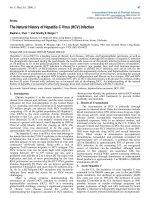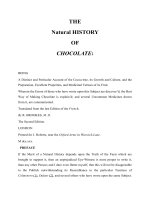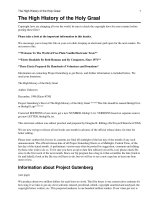the geological history of earth
Bạn đang xem bản rút gọn của tài liệu. Xem và tải ngay bản đầy đủ của tài liệu tại đây (2.93 MB, 66 trang )
The geological history of the Earth
Can be traced with the help of
Sedimentary rocks: composed of layers
Relative position of layers – information about the
relative age
Fossils
Scientists
produced
a geological
With the help
of these:
timescale
Geological timescale
Divided into units
Larger units = ERAS
Precambrian
Represent major phases in
the evolution of the planet
Palaeozoic
Mesozoic
Cainozoic
divided into periods
into epochs
into ages
The earliest events
The Earth is
4,6 billion
years old
Formed from a huge cloud of gas and dust
Meteorites played an important role in the early life,
added to its mass
The energy of collisions and nuclear
fission generated heat
Material became VERY
HOT
High temperature …
Led to the chemical differentiation
of the material into different layers
Iron and nickel sank into the centre
Less dense materials formed
concentric layers around the core
The young Earth had an atmosphere – it was lost
The Precambrian
The longest era
Represents 87% of the geological history
Divided into 2 parts
1.
Archeozoic
2.
Proterozoic
1. Archeozoic
continuous decrease of temperature
water – liquid
plates of the lithosphere had been formed
volcanic activity:
result : The
Composed
of atmosphere
first Permanent
carbon
dioxide,
ammonia,
steam
Oxygen
Appeared later in the atmosphere
The result of:
1.
UV radiation
2.
Photosynthesis
(after the appearance of plants)
The temperature of the surface became
cooler…
Under 100˚C
Steam
precipitated
The first ocean
was born
Stromatolites
Provide the first geological evidence of life
Rocks with special spherical structure
Blue algae play an important role in their formation
The oldest 2,9 billion years old
(Being formed in
present day Australia)
2. Proterozoic
Began 2,5 billion years ago
Several orogenies – produced
the oldest parts of the crust = the so-called shields
Shields form the core of continents
They were originally mountain ranges which were eroded
later
Later orogenies did not change them (!)
The Palaeozoic
1. Period: Cambrian
The first fossils – animals with hard parts (Skeletal
material)
Living beings could only be found in seas and oceans
The atmosphere did NOT filter the radiation of the
Sun
Continents were NOT
suitable for life
(3.) Silurian period
Plants were the first to conquer continents
(4.) Devonian period
The most significan changes: plants spread on land
and the first animals appeared on continents
2 important orogenies
I. Caledonian: Silurian period
Connected N America and Europe
Scandinavian Mountains
Mountains of Scotland
Caledonides
East Greenland
Northern section of the Appalachian Mountains
II. Variscian: Carboniferous period
Connected Gondwanaland with the complex of Europe and N America
+ Asian areas were added by
the Ural Mountains
South England
France
Mountains of Germany
The mountains surrounding the Bohemian Basin
Rhodope
Great Dividing Range in Australia
Southern section of the Appalachian Mountains
Velence Mountains
By the end of the Palaeozoic
All continents had been connected
Huge continent = Pangaea
Surrounded by one huge ocean = Panthalassa
Huge bay in the eastern part of the continent: Tethys









